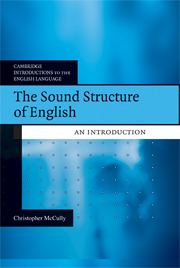Book contents
- Frontmatter
- Contents
- List of figures
- Acknowledgements
- A note on using this book
- 1 Introduction
- 2 Consonants (1): contrastiveness
- 3 Consonants (2): classification
- 4 Consonants (3): distribution
- 5 Syllables (1): introduction
- 6 Syllables (2): constituents
- 7 Syllables (3): structure
- 8 Vowels (1): short vowels
- 9 Vowels (2): long vowels and diphthongs
- 10 Vowels (3): variation
- 11 Problems, theories and representations
- Appendix: the IPA chart
- Glossary
- References
- Index of topics
- References
8 - Vowels (1): short vowels
Published online by Cambridge University Press: 05 June 2012
- Frontmatter
- Contents
- List of figures
- Acknowledgements
- A note on using this book
- 1 Introduction
- 2 Consonants (1): contrastiveness
- 3 Consonants (2): classification
- 4 Consonants (3): distribution
- 5 Syllables (1): introduction
- 6 Syllables (2): constituents
- 7 Syllables (3): structure
- 8 Vowels (1): short vowels
- 9 Vowels (2): long vowels and diphthongs
- 10 Vowels (3): variation
- 11 Problems, theories and representations
- Appendix: the IPA chart
- Glossary
- References
- Index of topics
- References
Summary
In this chapter …
In this chapter we focus largely on the system of short vowels as this is manifest in different varieties of English. Building on the work we've already done in chapter 7, we'll review the linked notions that short vowels are associated with one X-slot within the syllabic nucleus, whereas long vowels are associated with two X-slots. Then we proceed to draw a distinction between vowel quantity (length) and vowel quality (where and how a vowel is produced). In the remainder of the chapter we develop our analysis of vowel quality, and see that the crucial diagnostic for the description of vowels is the relative height and position of the tongue. This relative height and position can be matched against a stylised diagram of the oral cavity. Such a diagram is known as a vowel trapezium. Distinctive positions within that trapezium are associated with numbered reference points, which in turn are associated with the primary Cardinal Vowels. We shall see that nearly all varieties of English seem to have six distinctive short vowels, plus a seventh (central) vowel which characteristically occurs in unstressed syllables, and which we encountered earlier – schwa.
Establishing an inventory of short vowels
You'll recall from thelast chapter that short vowels are represented in syllable structure by the alignment of the relevant vowel segment with just one X-slot within the syllabic nucleus.
- Type
- Chapter
- Information
- The Sound Structure of EnglishAn Introduction, pp. 107 - 126Publisher: Cambridge University PressPrint publication year: 2009

